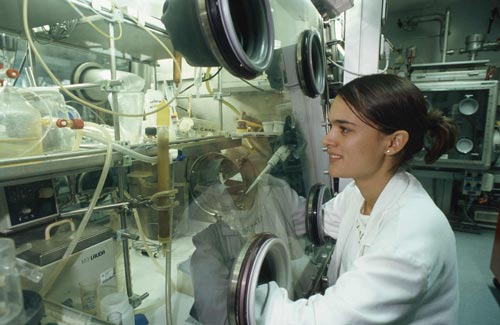Sorting radioactive waste has advantages

Hot chemistry
At Marcoule the CEA has a specialist facility called ATALANTE. It allows research for the separation of high-level waste. Called hot chemistry, it requires the handling of extremely radioactive material. Here one can see a filtration operation taking place in a glove box, as part of work on the separation of minor actinides.
© T.Foulon/CEA
As with household waste, sorting can prove really useful when it comes to managing radioactive material. It is performed industrially during reprocessing. The sorting or separation of radioactive material is also often called partitioning.
At the La Hague plant, partitioning is limited to the recovery of the uranium and plutonium considered to be reusable from the spent fuel from reactors. Partitioning has advantages. By removing the mildly radioactive uranium – which represents more than 90% of the mass of the spent fuel – you can reduce the volume of waste. The plutonium can be burned in a reactor to produce energy. Recovering the plutonium reduces the radioactive toxicity of the waste and the amount of heat it releases.
The glass residues from reprocessing, produced at the La Hague plant, are less toxic and release less heat than the spent fuel they come from. But because the separation process is not yet complete, they still contain some long-lived radioactive atoms (minor actinides). By removing these radioelements, it is possible to obtain lighter glass that will be back to the level of activity of natural uranium after three centuries, instead of the 10,000 or so years it would take for normal glass or the 200,000 years for spent fuel.
Partitioning radioactive atoms is a hot chemistry operation only made possible by the use of robotization. There are other difficulties too, of chemical origin. The heavy atoms to be separated out all have very similar properties. Partitioning is difficult in many respects, and active research into it is under way in France and elsewhere.
What do you do with the radioactive nuclei once they have been removed? The ideal solution would be to turn them into non-radioactive nuclei or nuclei that are still radioactive but would lose their radioactivity more quickly. That is the difficult task of transmutation. At present transmutation is used for plutonium, a fissile element.
Partitioning without transmutation can be useful. For example, if a radioactive element releases a lot of heat but disappears quickly, it can be conditioned separately for entreposing until it disappears. The waste that would ultimately need to be buried would release less heat and be less radioactive.
Other articles on the subject « Waste strategies »
Slow disappearances
Trapping radioactivity until it disappears A scenario for the long-term future of the waste It wi[...]
Oklo : a natural reactor
Nature at work over the last two billion years It was noticed by chance in the 1970s that a urani[...]
Diluting radioactivity
A practice for elements with low levels of toxicity Management of radioactive waste generally foc[...]
Putting it out of reach
Containment and burial when it is not enough to wait Letting time do its work is not sufficient o[...]
Conditioning
Packages for trapping radioactivity… Conditioning means containing the radioactivity and im[...]
Temporary storages …
Storing: a useful but temporary solution Storing means tidying an object away with the intention [...]
Deep geological disposal
Ground-level and deep disposal: a definitive solution Deep disposal of the most radioactive waste[...]
Destroy (transmutation)
Transforming radioactive nuclei to make them less troublesome… The incineration of househol[...]
What to transmute?
Transmuting long-lived actinides and fission products Long-lived elements: actinides and fission [...]
Transmuting actinides
Attractive in principle, difficult in practice Destroying actinides using fission reactions is at[...]